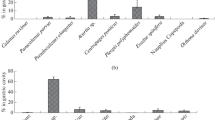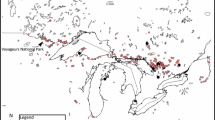Abstract
Along the mid-Atlantic coast of the US, the ctenophore Mnemiopsis leidyi (Agassiz) appears to be increasing in abundance and undergoing shifts in its historical seasonal distribution. We provide new data on shifting ctenophore abundance in Long Island estuaries and its implications for top-down control of the plankton community. Peak mean biovolume estimates of M. leidyi in Long Island estuaries in 2006 revealed ctenophore abundance values that were a factor of two to five times greater than previous studies conducted two decades ago. Furthermore, peak M. leidyi densities in 2006 occurred 2–3 months earlier than previously documented, suggesting a shift in the seasonal maxima of M. leidyi. Application of daily ingestion rates to zooplankton abundance indicates that, at its highest densities M. leidyi can remove an overall average of 20–89% per day of bivalve veligers and other zooplankton taxa, including adult copepods, nauplii, and tintinnids. Increasing ctenophore abundance, especially during a period when they were not historically abundant (i.e., June) may have significant consequences for species which spawn at this time. For example, current populations of M. leidyi represent a major source of larval mortality for bivalves which may inhibit recovery of shellfish populations and reinforce their low abundance state in Long Island estuaries.







Similar content being viewed by others
References
Bamstedt U, Gifford DJ, Irigoien X, Atkinson A, Roman M (2000) Feeding. In: Harris RP, Wiebe PH, Lenz J, Skjoldal HR, Huntley M (eds) ICES zooplankton methodology manual. Academic Press, London, pp 297–399
Burnham KP, Anderson DR (2002) Model selection and inference: a practical information-theoretic approach. Springer, New York
Burrell VB, Van Engel WA (1976) Predation by and distribution of a ctenophore, Mnemiopsis leidyi A. Agassiz, in the York estuary. Est Coast Mar Sci 4:235–242
Condon RH, Steinberg DK (2008) Development, biological regulation, and fate of ctenophore blooms in the York River estuary, Chesapeake Bay. Mar Ecol Prog Ser 369:153–168
Costello JH, Sullivan BK, Gifford DJ, Van Keuren D, Sullivan LJ (2006) Seasonal refugia, shoreward thermal amplification, and metapopulation dynamics of the ctenophore Mnemiopsis leidyi in Narragansett Bay, Rhode Island. Limnol Oceanogr 51(4):1819–1831
Crosby MP, Gale LD (1990) A review and evaluation of bivalve condition index methodologies with a suggested standard method. J Shellfish Res 9:233–237
Deason E, Smayda T (1982) Ctenophore-zooplankton-phytoplankton interactions in Narragansett Bay, Rhode Island, USA, during 1972–1977. J Plankton Res 4(2):203–217
Doall MH, Padilla DK, Lobue CP, Clapp C, Webb AR, Hornstein J (2008) Evaluating northern quahog (=hard clam, Mercenaria mercenaria L.) restoration: are transplanted clams spawning and reconditioning? J Shellfish Res 27:1069–1080
Duguay LE, Monteleone DM, Quaglietta CE (1989) Abundance and distribution of zooplankton and ichthyoplankton in Great South Bay, New York during the brown tide outbreaks of 1985 and 1986. In: Cosper EM, Bricelj VM, Carpenter EJ (eds) Novel phytoplankton blooms, causes and impacts of recurrent brown tides and other unusual blooms. Springer, Berlin, pp 599–623
Food and Agricultural Organization (FAO) (1990) Artificial propagation of bivalves: techniques and methods. SF/WP/90/3. http://www.fao.org/docrep/field/003/AB739E/AB739E00.HTM
Gall K (1999) New York’s hard clam industry. http://www.nyseafood.org/nysc/clams1.asp
Hare MP, Palumbi SR, Butman CA (2000) Single-step species identification of bivalve larvae using multiplex polymerase chain reaction. Mar Biol 137:953–961
Hinga KR (2005) Water quality and ecology of Great South Bay (Fire Island National Seashore Science Synthesis Paper). Technical Report NPS/NER/NRTR-2005/019
Kassner J (1993) Possible effects of reduced hard clam abundance in the Great South Bay. On the Water July/August, pp 4–5
Kremer P (1976) Population dynamics and ecological energetics of a pulsed zooplankton predator, the ctenophore Mnemiopsis leidyi. In: Wiley ML (ed) Estuarine processes. Academic Press, New York, pp 197–215
Kremer P (1979) Predation by the ctenophore Mnemiopsis leidyi in Narragansett Bay, Rhode Island. Estuaries 2:97–105
Link JS, Ford MD (2006) Widespread and persistent increase of ctenophora in the continental shelf ecosystem off NE USA. Mar Ecol Prog Ser 320:153–159
Main RJ (1928) Observations of the feeding mechanism of a ctenophore, Mnemiopsis leidyi. Biol Bull 55:69–78
Mills C (1995) Medusae, siphonophores, and ctenophores as planktivorous predators in changing global ecosystems. ICES J Mar Sci 52:575–581
Mills C (2001) Jellyfish blooms: are populations increasing globally in response to changing ocean conditions? Hydrobiologia 451:55–68
Monteleone DM, Duguay LE (1988) Laboratory studies of Predation by the Ctenophore Mnemiopsis leidyi on the early stages in the life history of the Bay Anchovy, Anchoa mitchilli. J Plankton Res 10:359–372
Nelson TC (1925) On the occurrence and food habits of ctenophores in New Jersey inland coastal waters. Biol Bull 48:92–111
New York Sea Grant (NYSG) (2006) NYSG’s hard clam research initiative: about hard clams and their industry. http://www.seagrant.sunysb.edu/HardClam/abouthardclams.htm
Newell RIE, Tettelbach ST, Gobler CJ, Kimmel DG (2009) Relationships between reproduction in suspension-feeding hard clams Mercenaria mercenaria and phytoplankton community structure. Mar Ecol Prog Ser 387:179–196
Omori M, Ikeda T (1992) Methods in marine zooplankton ecology. Krieger Publishing Company, Florida, p 85
Perino L (2006) Using PCR to determine the accuracy of morphological identification of Mercenaria mercenaria (L.) larvae. Master’s thesis, Stony Brook University
Purcell JE (2003) Predation on zooplankton by large jellyfish, Aurelia labiata, Cyanea capillata and Aequorea aequorea, in Prince William Sound, Alaska. Mar Ecol Prog Ser 246:137–152
Purcell JE (2005) Climate effects on formation of jellyfish and ctenophore blooms: a review. J Mar Biol Assoc UK 85:461–476
Purcell JE, Arai M (2001) Interactions of pelagic cnidarians and ctenophores with fish: a review. Hydrobiologia 451:27–44
Purcell JE, Decker MB (2005) Effects of climate on relative predation by scyphomedusae and ctenophores on copepods in Chesapeake Bay during 1987–2000. Limnol Oceanogr 50(1):376–387
Purcell JE, Cresswell FP, Cargo DG, Kennedy VS (1991) Differential ingestion and digestion of bivalve larvae by the schyphozoan Chrysaora quinquecirrha and the ctenophore Mnemiopsis leidyi. Biol Bull 180:103–111
Purcell JE, Shiganova T, Decker MB, Houde E (2001) The ctenophore Mnemiopsis in native and exotic habitats: US estuaries versus the Black Sea basin. Hydrobiologia 451:145–176
Purcell JE, Uye S, Lo W (2007) Anthropogenic causes of jellyfish blooms and their direct consequences for humans: a review. Mar Ecol Prog Ser 350:153–174
Quaglietta CE (1987) Predation by Mnemiopsis leidyi on hard clam larvae and other natural zooplankton in Great South Bay, NY. Master’s thesis, State University of New York, Stony Brook
Sullivan BD (2001) Evidence for seasonal range expansion by the ctenophore Mnemiopsis leidyi in northern coastal waters of the United States. RINHewS 8(2):2–4
Sullivan BD, Van Keuren D, Clancy M (2001) Timing and size of blooms of ctenophore Mnemiopsis leidyi in relation to temperature in Narragansett Bay, RI. Hydrobiologia 451:113–120
Turner JT, Bruno SF, Larson RJ, Staker RD, Sharma GM (1983) Seasonality of plankton assemblages in a temperate estuary. Mar Ecol 4(1):81–89
Acknowledgments
Support for this project was provided by New York Sea Grant, Project R/FBM-32. Boat time was generously provided by The Nature Conservancy, Long Island Chapter. We thank C. Clapp, A. Stark, J. Pan, T. Duffy, L. Perino, A. Webb, L. Holt, G. Wagner, J. Smith, S. Bell, A. Sabrosky, and R. Stern for their field assistance. We also wish to thank M. Patricio and G. Rivera at Cornell Cooperative Extension for very kindly providing bivalve larvae for use in the PCR reactions and M. Doall for providing condition indices. This is contribution #1387 of the School of Marine and Atmospheric Sciences, Stony Brook University. All experiments conducted comply with current national and state laws.
Author information
Authors and Affiliations
Corresponding author
Additional information
Communicated by J. Purcell.
Rights and permissions
About this article
Cite this article
McNamara, M.E., Lonsdale, D.J. & Cerrato, R.M. Shifting abundance of the ctenophore Mnemiopsis leidyi and the implications for larval bivalve mortality. Mar Biol 157, 401–412 (2010). https://doi.org/10.1007/s00227-009-1327-6
Received:
Accepted:
Published:
Issue Date:
DOI: https://doi.org/10.1007/s00227-009-1327-6




